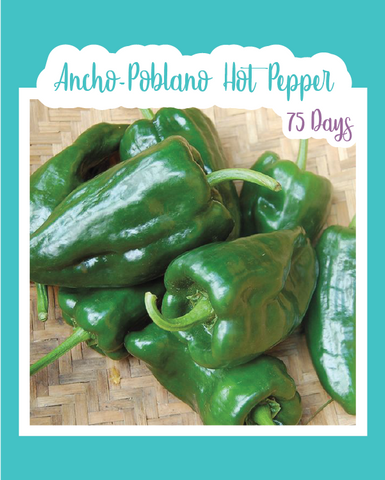
Cayenne Long Slim Hot Pepper
Seed Count: Approx. 20 seeds
Days to Maturity: 75-90 days after transplant
Description: Cayenne Long Slim hot peppers are forever a staple in my garden, since I love to make my own pepper flakes. This plant produces heavy yields, of long 4-6 inch slightly straight to curved, wrinkled fruit, so your pepper stash will rack up quite quickly. These attractive, thin walled peppers are on a medium spicy level, around 30,000-50,000 SHU, and turn a gorgeous bright red when ripe. This pepper dries well, and is also great to make chili, salsas, hot sauces, and pickles with. This plant grows pretty compact and bushy, about 2 ft. tall, so it's one of my favorite to grow in containers. It's also quite ornamental, and looks like a tree covered in retro Christmas lights, once it's covered with ripe fruit.
Mint2Grow Tip: Cayenne peppers also freezes well, which is perfect, because it can produce more than you can handle at once pretty quickly. I only ever need one plant, but of course I go planting crazy, and end up with more than I need. Please use gloves when handling these peppers, the heat lingers on your hands, even after washing them several times, and I have swollen my eyes shut before from not being careful when handling peppers with heat.
How To Grow
Sowing: Start pepper seeds indoors in peat pots, about 8 weeks before your last expected spring frost. Sow them 1/4 of an inch deep, and keep the soil at 80-85 degrees F until they germinate. If the soil is too cold it may not germinate. I also find that the hotter the pepper is, the longer those seeds take to germinate. Provide seedlings with adequate sunlight or a grow light for 12-16 hours a day. When the outdoor temperature reaches 60-65 degrees F during the day and no less than 50 degrees F at night, you can transplant your seedlings. Space them about a foot and a half apart. Exposing the plants to the weather for several hours a day before transplanting may help prevent transplant shock. Peppers grow well in containers or raised beds. I grow mine in 5-10 gallon grow bags depending on how big the variety will eventually get. Since I live in a warmer climate, they become full sized, and can survive for over a year, so I have to take that into consideration when choosing their homes.
Growing: Keep the soil evenly moist and weeds under control. Mulching your plants may help with this. If excess heat and sun cause the plants to wilt, provide shade them with shade and ample water, but be careful not to over water them. Usually my peppers survive my hot summers, so I wouldn't worry much about it. Peppers are prone to blossom end rot, so I always make sure to start them with high amounts of nutrients, so I always mix in powdered egg shells, bone meal, and Epsom salt into the soil. I also feed them with fish emulsion and Fox Farm's Tiger Bloom, once a month, to ensure that I get lots of peppers with none of the rot. My peppers always get plagued with white flies, aphids, and scale, so an organic horticultural spray could be beneficial. Companion plant with basil, coriander, onions, spinach, and tomatoes but do not inter-plant with beans.
Harvesting: When to harvest hot peppers is basically a matter of personal preference. Generally speaking, the longer the peppers mature on the vine, the hotter they will taste. I've also found that decreasing the amount of water, as they mature, makes for significantly hotter peppers. Mature peppers will signal the plant to stop producing, so I pick them often. However, my peppers have always been productive, regardless of if I let them mature on the plant or not. Always use a knife or scissors to remove peppers from the plant to prevent damage to their fragile stems. Peppers are extremely versatile and can be used fresh, dried, or for seasoning. You can even make delicious pickled peppers or delicious pepper sauces and pastes. If you plan to save seeds, keep in mind that peppers will cross pollinate with other varieties of pepper, so isolation may be necessary to preserve its genetic purity. Allow peppers to fully mature, then cut them open, and remove the seeds. I give the seeds a little rinse, then I spread out the seeds to dry for about two weeks. Store the seeds in a cool, dry place for up to two years.




